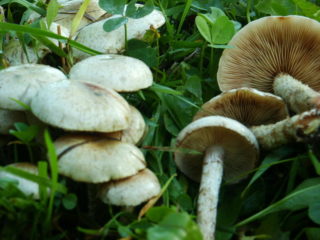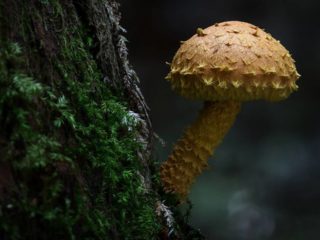Content
Alder flake (Pholiota alnicola) or alder moth is a bright yellow or orange mushroom that contains toxic substances. The lamellar mushroom belongs to the Strophariaceae family, is poisonous, grows on stumps or weakened deciduous trees, most often on alder.
Description of alder flake
Alder scale is a common mushroom in deciduous forests. It grows in clumps, forming dense families that completely cover an area of wood. Young specimens are yellow.If the mycelium is located in a shaded place, then as the mushroom matures, the color becomes lemon, then acquires a rich orange color. In the open, the fruit body is beige with ocher spots on the cap.
Description of the cap
Alder flake is a small mushroom. The diameter of the cap in mature specimens does not exceed 5 cm.
Description of the alder moth cap:
- Young mushrooms have a regular round shape. In more mature ones it is cylindrical. At the moment of ripening of the flake, the cap becomes prostrate, the edges are concave with even or torn remains of the film coating.
- The surface is unevenly painted, the central part is darker. The outer side is strewn with small, well-fixed scales, which can only be distinguished upon close examination.
- The protective film is dense, oily, slippery even at low humidity.
- The spore-bearing plates are densely located, they are smooth, with a clear boundary near the fruit stalk. Painted yellow, then light orange with a brown tint.
- The pulp is fragile, yellow, very thin, with a sharp, sickly sweet smell and bitter taste.
Description of the leg
The leg of the scale is short - up to 4 cm, cylindrical in shape, straight-growing or slightly curved in the middle.
Thinner at the top than at the base. It is unevenly colored, dark brown near the mycelium, light yellow or orange in the middle, and does not differ in tone from the surface of the cap. The structure is rigid, fibrous, solid. Surface with a light felt coating.
Edibility of alder moth
The scale attracts attention with its friendly growth and bright coloring of the fruiting body. The mushrooms are all of equal size and height with clean caps. These are all the advantages of the species.The flake has a pungent, bitter taste that persists after cooking, with an unpleasant, ethereal, sweet odor, which also cannot be gotten rid of.
The chemical composition contains toxic compounds that can cause poisoning with severe symptoms, but the concentration of toxins is not lethal for humans.
Symptoms of poisoning, first aid
Cases of poisoning by alder flake are extremely rare; the fruiting body should not be consumed in any form. In case of intoxication, symptoms appear after 2 hours and gradually increase:
- mild nausea;
- then the headache begins;
- the symptoms are accompanied by continuous vomiting;
- there is pain and pain in the stomach, sweating;
- Diarrhea complements the signs of poisoning.
Possible increase in body temperature. If measures are not taken in a timely manner, the body faces dehydration and complications in the kidneys, heart or liver. It is impossible to remove toxins from the body at home; you must contact the nearest medical facility or call an ambulance. Before providing qualified assistance, you can alleviate the symptoms:
- Make a weak solution of manganese and wash the stomach.
- Accept sorbents: white or activated carbon, “Polysorb”.
- You cannot stop diarrhea if the symptom has not yet appeared by drinking laxatives or washing the intestines with a manganese enema.
- If you feel chills, take a hot bath or wrap yourself in a blanket.
Where and how does it grow
Alder scale is found in all regions, feels comfortable in temperate and warm climates, the main condition necessary for growth is a humid environment. It is a saprophyte, parasitizes on deciduous dead trees, stumps or weakened trees, appears at the end of summer and grows until mid-October. Forms dense colonies and never grows alone. The main cluster is Central Russia and the Ural region.
Doubles and their differences
The alder flake has no recognized counterparts, but the sulphurous honey fungus is similar in appearance to the moth.
The growth season of the species coincides. The external resemblance is also obvious. But honey fungus is not a saprophyte; it grows on a bed of moss and leaves. The cap is yellow or light brown, the leg is hollow without a felt covering. The main distinguishing feature from the flake is that the plates of the false foam are gray in color with a light blue or steel tint. The surface of the cap is dry without scales. The false honey fungus has a pleasant smell and taste; the species is classified as edible.
Conclusion
Alder flake is an inedible toxic mushroom that can cause serious poisoning. Grows in mixed forests on deadwood trunks and stumps. Can only grow in symbiosis with trees. Forms dense colonies and has a bright attractive color. The taste is pungent and bitter, the smell is pungent and unpleasant.















